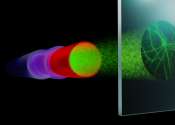System of flat optical lenses that can be easily mass-produced and integrated with image sensors
Engineers at Caltech have developed a system of flat optical lenses that can be easily mass-produced and integrated with image sensors, paving the way for cheaper and lighter cameras in everything from cell phones to medical ...








